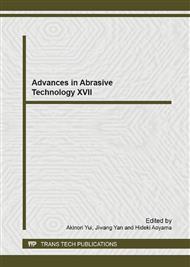p.663
p.669
p.675
p.681
p.686
p.692
p.696
p.705
p.709
The Topographic Characterisation of Grinding Wheels – A Proposed Measurement Strategy
Abstract:
The surface of the grinding wheel and the conditions under which it is prepared has a profound influence upon the grinding performance as characterised by the grinding forces, power consumption, cutting zone temperature and component surface finish. Only by having a clear understanding of the wheel topography can the interaction of the grinding wheel surface with the workpiece be fully understood. Two dimensional measurements or profilometry, while being a relatively quick measurement to perform, suffers from information quality issues due to the subjectiveness of the profile location as well as questions regarding how representative a profile is of a three-dimensional real surface. While profilometric measurement has long been standardised in the form of various international standards, topographic standards have only recently been agreed upon and formalised as ISO 25178. In this paper a comprehensive approach to wheel topographic characterisation will be undertaken. Factors such as measurement strategy, filtering, active grain identification as well as the fidelity of surface replication will be considered. The paper will propose a recommended measurement strategy and surface parameter set deemed sufficient to provide a comprehensive understanding of the grinding wheel topography.
Info:
Periodical:
Pages:
686-691
Citation:
Online since:
September 2014
Authors:
Keywords:
Price:
Сopyright:
© 2014 Trans Tech Publications Ltd. All Rights Reserved
Share:
Citation:


